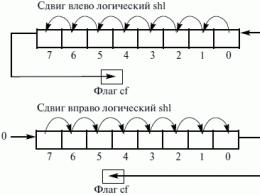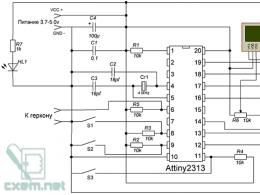Sports breaks. Break in sports - is it necessary to take a week break in training
Some changes may be noticeable immediately, while others may take several months to affect your exercise routine. So what happens when you don't have time to go to the gym time after time?
Coming back to the gym after a short break, you may feel like a beginner lifting weights for the first time. And if you've ever tried to run after a pause, you know how painful it can be. The change in the level of training is quite real and at times quite discouraging, both physically and psychologically. But how much can it prevent you from achieving your fitness goals? And how much do you need to spoil all the gains that you got from hard training?
So, let's look at what happens to your body when you fall out of the regime (everything happens in life), and what progress you will lose.
Skipping a couple of days or even a week of training really won't affect you much.
Indeed, sometimes your body needs rest. According to Chris Dobroselsky, consultant and spokesman for the American Council on Physical Education, founder of Monumental Results Inc., for most people who exercise regularly (four to six sessions per week), a week off is an opportunity to relax, refresh the mind and body. If frequent rest does not become your bad habit, then you will not need to worry about losing shape.
The biggest risk of taking a week off from training is actually more psychological. “For a beginner, an exercise program is a huge motivator, and after a week off, it can be hard to get back together,” says Steve Ball, Ph.D., assistant professor of nutrition and exercise at the University of Missouri. “Some drop out and never return.” We understand that you had to take a break and if you need more motivation to get back to the gym, try these simple yet effective programs.
But within about two weeks without exercise, aerobic conditioning begins to noticeably decline.
Aerobic exercise (like light long-distance running) affects your heart and lungs. “VO2 max is a measure of your ability to absorb and utilize oxygen during exercise,” explains Tara Plyushch, Senior Clinical Physiologist at NYU Langone Rusk Rehabilitation Medical Center. The more you exercise, the more efficient your lungs and heart become in terms of circulating fresh oxygen and blood throughout your body. As a result, your VO2 max improves.
When you stop exercising, your VO2 max and your heart's ability to pump blood efficiently begin to decline. The exact figure will vary in one direction or another, but research shows that after about two weeks of no exercise, you yourself will notice some changes. “A good example of endurance athletes is that after four weeks of not exercising, their VO2 dropped by 20 percent,” Plyushch says. "There are a number of studies that show a seven percent reduction in VO2 max after 12 days of no exercise." When it comes to the average person who goes to the gym, experts say they will begin to feel these changes in about a couple of weeks. At the same time, Steve Ball notes that signs of detraining may appear approximately on the 10th day from the moment of cessation of training.
When it comes to strength training, breaks in classes are not so noticeable.
There are many conflicting studies that talk about muscle loss due to age, gender, and your initial muscle volume, which will be very different if you have endurance rather than powerlifting skills.
But, as a general rule, for the average trainee who lifts heavy weights several times a week, a short break from training won't really cause much muscle loss. “Strength and muscle mass change very little over the course of a couple of weeks, so you shouldn’t pay attention to it,” says Dobroselsky. “A person who works towards increasing muscle mass can quit for four to ten weeks and look great, then return to the gym and easily perform all the exercises.” Thus, although there is still a decrease in the level of training, it is not as significant as in the case of conventional aerobics. Studies show that the strength of muscle fibers remains the same even after a month of not exercising, but you may experience a certain loss in some specific physical skills.
It's perfectly normal to feel a slight drop in strength (which is why you want to loosen up your training schedule after a long absence). Your mental attitude, like your muscles, has given up a little after the break. You will need coordination and good muscle memory to work with the same loads, so the old habitual weight may seem more heavy to you.
The higher your physical fitness, the faster you will notice signs of detraining. But the likelihood that you will go down to your entry level is also low.
It may seem unfair, but since your body is already built to work consistently at a high level, you will notice a difference much sooner than someone who works irregularly or at a much lower intensity. And this applies to both aerobics and strength training.
“A well-trained athlete will experience some aerobic decline during the first to third week,” says Dobroselsky. But at the same time, he will notice it earlier, immediately after the start of the break, and the decline in this case, unlike the decline of the beginner, will be more gradual. “The less trained athlete will not experience significant changes during the first to third weeks, but from the fourth to the eighth, his physical or aerobic capacity will most likely slip to zero.” More experienced athletes can expect a certain drop in fitness level after four to six weeks, retaining their abilities much longer than beginners.
Factors such as age and gender can also affect detraining score. For example, a study found that older women lose muscle mass faster than younger athletes.
It is better to choose a few short, high-intensity workouts for yourself than to skip a session entirely.
Yes, something is better than nothing. Even if your level of fitness after missing classes does not fall completely, the losses can be quite significant. Steve Ball notes that a trained athlete can experience a 25 percent decrease in their physical strength (as measured by the VO2 system) within a few months. “As a rule, the longer the break, the more pronounced this effect. Also, recovery often takes longer than the downturn itself.”
So, instead of skipping weeks or months of class, Dobroselsky recommends cutting back but increasing the intensity on class days. Chris suggests that if you're pressed for time, you should just work harder in your workout. Ultimately, you are aiming for a well-balanced training routine that you can sustain for the long haul. So if you have to change your schedule from time to time to better stick to it, that's fine. Just try to get back to normal as much as possible.
Zozhnik decided to figure out how much time without training will really pass before we start to lose shape.
Each of us skips workouts for various reasons. But we know very well that often even an unplanned absenteeism of one workout, like a snowball, develops into absenteeism of 3, 5 and 10 workouts. At the same time, many people fear that if they miss one workout, they will immediately lose their sports form.
In the process of regular training (especially intense) our body is in a stressful state. That is why from time to time it is necessary to take a short break in training in order to allow our central nervous system, muscles, ligaments, tendons and bones to recover. But it is important not to overdo it with the length of the rest, because otherwise the “use it or lose it” rule will come into play, which implies the loss of specific abilities of our body (muscle volume, endurance, strength) with the cessation of training.
Science says that there are 2 major factors that affect the rate of loss of form: the length of the break and the level of training at the time of its beginning.

How Quickly Experienced Athletes Lose Shape
It is much easier to regain the lost level of fitness if you have been training regularly for a long time. Simply put, if you have been training systematically 3-4 times a week for more than a year, your muscle memory and endurance will remain better than beginners.
It's also important to emphasize that fitness loss can worsen at different rates depending on whether you're doing strength training or cardio.
Loss of strength
Most experienced athletes begin to lose strength after 2-3 weeks of cessation of training, but this also depends on the conditions in which the body is located during the break. If you are sick and your body is under stress, you will start to lose strength after 2-3 weeks. If you are healthy and move enough, a significant loss of strength indicators will begin to be felt only after the 4th week.
In 2001, the American College of Sports Medicine (ACSM) journal MedicineinScienceandExercise published a review of several studies that examined the effect of training breaks on the strength performance of runners, rowers, and strength athletes. All groups of trainees showed a minimal decrease in strength even after the onset of the 4th week without training.
However, the following feature was noticed: while the overall strength indicators practically did not decrease, the specific muscle fibers of the athletes began to noticeably lose in strength. In endurance athletes, most of the "slow" muscle fibers (just responsible for a large number of repetitions) have significantly lost strength. In power workers, the same changes were observed in type II fibers (responsible for strength).
Loss of aerobic capacity
According to sports medicine expert Elizabeth Quinn, the loss of aerobic capacity in experienced athletes happens quite quickly. The specialist mentions a study in which experienced athletes completely stopped exercising for 3 months after a year of training. As a result, scientists found that in 3 months the endurance performance of athletes decreased by as much as 50%.
Also in 1985, scientists from Denmark conducted an experiment involving 9 experienced athletes training in an aerobic style. Before the start of the experiment, the participants allocated endurance training from 6 to 10 hours per week. During the trial period, their workouts were reduced to one high-intensity 35-minute session per week. After 4 weeks, endurance performance in athletes decreased by 21%.
But don’t get discouraged, as strength and conditioning expert Molly Galbraith says, although endurance performance drops more compared to strength, experienced athletes quickly return to their previous level.

How quickly beginners lose shape
If you have only recently entered the world of fitness and for some reason are forced to take a break from training, you should not stretch this period for a long time. The main key to achieving any fitness goals is the consistency and regularity of training, and here it is very important not to lose the gained momentum too soon.
Loss of strength
Strength indicators of beginners are better preserved and recover faster after a break in training compared to athletes. And this is logical: the further a person has gone from the usual level in his sports development, the more difficult it is for him to keep himself at this high level, respectively, and the loss in fitness is higher for any reason. And vice versa - beginners do not have much to lose compared to athletes. And science confirms this.
Let's turn to a curious study, which was conducted in 2011 by Japanese scientists. During their experiment, 15 beginners were divided into 2 groups. Both groups performed flat bench presses at a high level of intensity. At the same time, the first group trained for 15 weeks in a row, and the second after 6 weeks of training took a 3-week break and resumed training for the next 5 weeks. After 15 weeks, the scientists compared the results and found that in the end, both groups of subjects had identical strength indicators.
Loss of aerobic performance
However, with aerobic performance, everything is exactly the opposite. There is quite a bit of research on this topic, but we found the following. According to the same Elizabeth Quinn, beginners lose their aerobic performance much faster than experienced athletes. The specialist refers to an experiment in which beginners leading a sedentary lifestyle trained on exercise bikes for 2 months.
After 8 weeks, the subjects showed significant improvements in the functioning of the cardiovascular system, their aerobic performance also increased significantly. But as soon as the subjects took a 2-month pause, the scientists found a loss of all improvements. As a result, the subjects fully returned to the level of aerobic abilities that they had before the start of training.

How to slow down fitness loss
Whether you've taken a scheduled break from your workouts or you've had a health issue, there are ways you can help slow down the loss of your fitness.
- Do light cardio
If your physical condition allows, do a few easy runs per week. So you can slow down the loss of your aerobic performance.
- Connect strength training
There can be many reasons for stopping strength training, including injury. However, if the damage is localized, for example, in the ankle or wrist, it is not at all necessary to use your injury as an excuse. For example, nothing prevents you from doing crunches with an injured wrist or swimming a short distance freestyle with a minor finger injury.
If you have a really serious injury or you have a cold and lie in bed with a high temperature, in this case, you should completely refrain from any training.
- Eat Right
Proper nutrition during the training pause will help slow down the loss of muscle mass and avoid swimming with a layer of fat. Eat enough protein, choose healthy sources of carbohydrates and fats. Also, during the rest period from training, it is important to observe the principle of rational nutrition, in which the amount of energy received should be equal to its amount expended.
CONCLUSION
In fact, sports form is not lost so quickly, but if you an experienced athlete You don't have much to worry about at all. In general, the more experienced the athlete, the easier it is for him to regain his level of strength thanks to muscle memory, and the slower his aerobic abilities are lost, which he can relatively quickly restore.
At newcomers everything is a little different. While they don't need to worry about a temporary loss of strength as they quickly return after resuming training, things are different with aerobic performance. But that's why they are beginners, that their aerobic abilities are not so well developed as to be afraid to lose them.
Sources:
o How long does it actually take to get out of shape, greatlist.com.
o How fast do I lose fitness if I stop exercising, about.com.
o Madsen K., Pedersen P.K., Effects of detraining on endurance capacity and metabolic changes during extended exhaustive exercise, Department of Physical Education, Odense University.
o Ogasawara R., Yasuda T., Effects of periodic and continued resistance training on muscle CSA and strength in previously untrained men, Graduate School of Frontier Sciences, The University of Tokyo.
o Mujika I., Padilla S., Cardiorespiratory and metabolic characteristics of detraining in humans, Departamento de Investigación y Desarrollo, Athletic Club de Bilbao, Spain.
Break in training: a few days, a week, a month and even more. Everyone can have unforeseen (or foreseen) circumstances due to which they will have to miss training. Illness, vacation, relocation, repairs, maternity leave - anything. Returning to "working mode" is difficult both psychologically and physically. A person feels a big rollback, strength indicators have fallen, and now it is difficult for him to lift weights that used to be warm-ups.
Many begin to press and pull with the same weight as before the break. The easiest consequence is the strongest krepatura in the morning, which again sends you to rest for several days. Many people get injured during this period, because they do not take into account such an important property of the body as adaptation. Our body changes under the influence of training, becoming stronger, but it also changes in conditions when training stops.
Break 1-2 workouts
Many beginners, at the very least, having built a regime, are very panicked, having missed 1-2 workouts. Here the problems are only psychological, and there is no need to talk about any losses in strength and muscle mass. For a few days of a break, it is simply impossible to lose all the adaptive changes that have occurred in your body under the influence of training, whether it be strength, endurance or muscle growth.
More often than not, people train too much, too hard, and too often. And then a short break can even be beneficial - the muscles rest, the central nervous system rests.
Some trainers (for example, Cosgrove) advise taking planned weekly breaks at the end of each training cycle (1-3 months), which allow not only the muscles, but also the nervous and endocrine systems to fully recover.
Break 1-2 weeks
After a week-long break, you can already notice a slight decrease in the level of fitness, although a lot depends on the reason for the break: if you were sick, this is one thing, but if you were actively relaxing on skis, for example, this is quite another.
In any case, the first "under the distribution" is strength. You become a little weaker, not because of muscle loss, but because of a decrease in neuromuscular coordination. Many people believe that strength is directly related to muscle size, and a decrease in strength, accordingly, is a consequence of muscle loss. But there is no direct connection between muscle size and strength, because strength is the work of the nervous system, that is, the ability of the brain to include more muscle fibers through the nervous system. More fibers included - more weight you can lift. This ability recovers very quickly, a matter of a few workouts.
Lyle Macdonald gives this advice:
It takes twice the time you missed to get back to where you left off before the break. If you missed 2 weeks, aim for approximately 4 weeks of smooth return to the weights you left off on. Of course, when the break in training is longer (a month or more), this rule ceases to be so strict, but the general idea is the same: the longer the break, the longer the recovery and smooth return to working weights. And here, how to properly return to training plays a big role.
Break for a month or more

What not to do
This is a more serious break. You definitely shouldn't start where you left off. The state of your body is completely different from before the break, and it’s stupid not to pay attention to it: the changes have affected the nervous system, endocrine, and connective tissue. If you decide that this is not for you, one of two things is very likely to happen: either you will get injured, or you will earn such a strong muscle that you will again cause a break in classes.
What to do
After a long break (note that coming back from an injury is different from taking a break for other reasons), you should start training like a beginner, although it's sad to admit, especially if you have several years of regular training under your belt.
Gradualization gives the body time to adapt to strength training again. The connective tissue adapts the slowest - tendons, ligaments, etc. The “losses” from a slower return to working weights are much less than the losses from injuries that can happen on the very first workout and again “save” you from the gym for a long time.
The good news is that recovery after a break, even if you started as a beginner, is much faster than adapting to training from scratch. The returnee will not have to learn technique for a long time, master complex movements, learn coordination and the ability to include the necessary muscles in work, develop strength. The body remembers all this very quickly. For the same reason, with proper training, lost muscle mass returns quickly enough.
You need to start with a low intensity: about 50-60% of your working weights before a break and reduced volume. For simplicity, the first week you can train by reducing the weight in half. Then, every two or three workouts, increase the weight a little, provided that you do not feel severe muscle soreness on rest days.

For the first workouts, it is enough to perform one approach per exercise in the number of repetitions of 10-15, but not to failure. Strive to ensure that your efforts correspond to 5-6 points on a 10-point scale.
As for the choice of exercises, it can be like your regular program, but cut in volume and weights, or a beginner's basic training - work on simulators in single-joint movements. It all depends on how regularly and for how long you practiced before the break (your seniority and experience), how long your break was and what caused it (injury or something unrelated to health).
That is, once again: returning after a long break (more than a month), train like a beginner and reassure yourself that progress will go many times faster compared to a real beginner.
About injuries
Returning to training after an injury is a separate issue, which, ideally, requires the advice of a doctor. The most important question is: Was the injury completely healed?
Most people try to get back into training too quickly, before the aftereffects wear off. And of course, an untreated injury is a way to get hurt again.

Lyle MacDonald advises:
To be on the safe side, wait until you think the injury is over, and then deliberately wait another week beyond that. This break will be much less than the break that you will be forced to take if you re-injure (and the likelihood of this is very high). In addition, injuries are different. Some pass quickly and without a trace, some will bother you for a very long time - for example, injuries of the shoulder joint.

 After a long break in training, it is not so difficult to restore your previous shape. The fact is that most of the muscle volume is lost due to the lack of neuromuscular stimulation. But the neural pathways that were created in previous workouts remain forever. As soon as training is resumed, the created neural pathways begin to work again, and muscle mass is gained faster. Thus, you can quickly recover to your previous form, but it will be more difficult to progress further.
After a long break in training, it is not so difficult to restore your previous shape. The fact is that most of the muscle volume is lost due to the lack of neuromuscular stimulation. But the neural pathways that were created in previous workouts remain forever. As soon as training is resumed, the created neural pathways begin to work again, and muscle mass is gained faster. Thus, you can quickly recover to your previous form, but it will be more difficult to progress further. In 2013, the following experiment was conducted among beginners - beginner athletes performed strength work for six months and were divided into 2 groups. The first group trained without any breaks for all 6 months, and the other part of the athletes took 2 breaks with a duration of 3 weeks. The results were amazing - breaks during training for beginners did not reduce either strength indicators or muscle volumes. More precisely, during the break, the strength and volume of muscles decreased, but when returning to training, the growth of muscle mass and strength indicators occurred twice as fast as in the first group. And here are the results of similar interesting experiments:
In 2013, the following experiment was conducted among beginners - beginner athletes performed strength work for six months and were divided into 2 groups. The first group trained without any breaks for all 6 months, and the other part of the athletes took 2 breaks with a duration of 3 weeks. The results were amazing - breaks during training for beginners did not reduce either strength indicators or muscle volumes. More precisely, during the break, the strength and volume of muscles decreased, but when returning to training, the growth of muscle mass and strength indicators occurred twice as fast as in the first group. And here are the results of similar interesting experiments:




